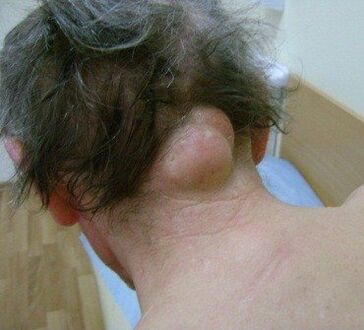
The neck of humans, like other animals, is an incredible part of the body, very fragile but strong.
The cervical spine, along with all the muscles and ligaments, supports and mobilizes the skull, absorbs shocks while walking, protects the brain from concussions, protects the blood vessels that feed it, and protects the spinal cord.
Almost everyone can say that they have had neck pain all their lives. Neck pain can affect both men and women at any age.
The causes of neck pain can be very different. Some can resolve themselves within a few days, while others can cause chronic illness and pain.
Why does pain occur?
The most common cause of neck pain is bad posture. With the head bent, the head stops holding a position just above the body and moves forward. In this situation, the neck muscles and ligaments experience increasing tension. The development of flexion and neck pain is facilitated by working for a long time without changing position, lying on a soft bed or high pillow, prolonged static loading.
Other causes of neck pain include a head injury, a car accident, or an injury while playing sports. Makes a sharp acceleration and then the action of cervical spine with the brakes. As a result, ligaments and muscles can stretch excessively, cervical vertebrae become displaced or compressed fractures, and intervertebral hernias form.
Neck pain can occur as a secondary manifestation of other diseases. For example, during a heart attack, when the heart attack causes severe pain, it spreads along the nerve plexuses to the upper extremities, chest, and neck. Shortness of breath, sweating, nausea, vomiting - neck pain with a heart attack is only part of a larger symptom complex. If you have pain in your neck, jaw and other signs of a heart attack, you should call an ambulance immediately.
Neck pain is also used as a diagnostic sign of meningitis. With this disease, the neck muscles become hypertonic, ie stiff. The back of your neck hurts a lot when you try to bend your head to your chest.
Spinal pain in the neck region is accompanied by rheumatoid arthritis, osteoporosis, fibromyalgia, spondylosis and osteoarthritis, hernia or bulge, compression of nerve roots or spinal cord with infectious edema, abscesses, tumors or benign neoplasms.
Special cases
Degenerative diseases
Osteochondrosis, or in other words, dystrophic disorders of the intervertebral discs, causes constant pain in the neck. It is a mild aching pain that is usually accompanied by numbness and pain in the shoulder girdle and head.
The neck area affected by osteochondrosis can lead to the development of cerebral artery syndrome. With the reduction of the intervertebral distances in this region, a compressive damage occurs to the vertebral arteries at the openings of the transverse processes of the cervical vertebrae. It causes a decrease in blood flow to the brain by reducing pressure on the vessel, dizziness, vision and hearing. On the other hand, mechanical stimulation of the artery by vertebral pressure causes a reflex spasm that manifests itself as a burning pain in the head.
Treatment
If the neck is constantly sore on the background of osteochondrosis, therapy begins with the elimination of the pain syndrome. The second mandatory treatment is to stop the degenerative processes in the cervical vertebrae.
Painkillers can be obtained using the following groups of drugs:
- non-steroidal anti-inflammatory drugs directly block the cascade of pain-mediating mediators;
- muscle relaxant - eliminates muscle spasms caused by severe pain;
- sedatives - calms and inhibits the nervous system and the transmission of pain impulses (valerian, antidepressants, sleeping pills);
- vasodilators - help relieve vertebral artery syndrome and associated pain.
In osteochondrosis, chondroprotective drugs are prescribed to prevent the destruction of cartilage and spine, as well as multivitamin mineral complexes to eliminate the cause of neck pain.
Pain treatment also includes physiotherapy, physiotherapy, massage, pulling, reflex and banding therapy. It is recommended that the patient wear a special collar that protects the neck from excessive mobility to relieve pain during exacerbation.
Muscle pain

Neck pain can occur when the muscles in the neck become inflamed.
Such pain should be distinguished from neuritis (inflammation of the nerve trunks with sensory disturbances) and pain caused by osteochondrosis.
Myositis occurs suddenly, after exposure to predisposing factors - hypothermia, tremors, long-term overload, especially long-term repetitive movements of the same type.
Cervical myositis is characterized by sharp pain that occurs when an inflamed muscle contracts. The severity of the pain makes it difficult to perform certain types of movements.
Generally, the long muscles of the neck or sternocleidomastoid muscles on the anterolateral surface ache, which pulls the head back with a bilateral contraction and turns it with a unilateral contraction.
The deep muscles surrounding the spine also often become inflamed, causing the neck and back to move.
When examining a muscle, an increase in tone and dense nodular areas are noted. Disruption of microcirculation and local trophism leads to the gradual replacement of myocytes with connective tissue. As a result, the neck muscles weaken, the symmetry on the sides of the spine is disturbed, torticollis may appear, and it is difficult for the patient to keep his head straight.
Treatment
Treatment begins with reducing the tension in the neck. This is followed by a course of physiotherapeutic procedures - heating with UHF, electrophoresis with drugs, heating with paraffin, wrapping with ozokerite, diathermy, massage, acupuncture. Such procedures restore blood circulation to the neck muscles. Medications include B vitamins, anti-inflammatory and analgesic drugs, ointments and rubs.
Alternative treatment recommends the use of cabbage or burdock leaves as a painkiller compress, an ointment made from willow buds beaten in butter, rubbed with a mixture of apple cider vinegar and egg yolk and turpentine. The neck is also rubbed with lava oil and then wrapped. The main guarantee of the success of any treatment is to keep the sore throat calm until the muscles are fully restored. Then you need to start to return them to their "position" with special gymnastics and massage.
Radicular syndrome
Severe neck pain, which spreads to the muscles of the head, shoulder girdle, and upper extremities, can occur when the roots of the spinal nerves are compressed during prolapse, protrusion, or herniated discs.
With this disease, the inner nucleus of the disc protrudes into the spinal canal or lateral horns. Hernia and its symptoms are usually visible on one side. When there is pressure on the roots of the spinal nerves, there is a sharp burning pain in the innervated muscles (cervical lumbago). The patient feels numbness in the lower jaw, around the ears, back of the head, shoulder blades, arms. Dizziness and sharp pains in the neck appear when moving the position from the horizon to the vertical position. The gradual removal of the disc nucleus causes damage, inflammation and maturation of the surrounding tissues. This creates the preconditions for inflammation of the nerve endings with the development of radiculitis, the mobility of the neck and upper extremities is gradually limited. Prolonged damage to the spinal nerves leads to paresis or paralysis of the extremities.
Therapy
What to do if it hurts with a hernia? At home, with pain syndrome, painkillers, non-steroidal anti-inflammatory drugs, hormonal medications, muscle relaxants are taken to relieve spasms.
In the hospital, severe pain in the neck is relieved with the help of "blockades" - the introduction of anesthetics on the sides of the spine.
Swelling and inflammation are treated with steroids that can be injected directly into the hernia. Muscle pain is relieved by taking a muscle relaxant.
I also use chondroprotectors, which strengthen cartilage tissue to prevent the hernia from developing further.
In many cases, therapeutic exercises and traction with a cervical spine bulge or slight bulge help. Increased intervertebral space helps to "pull back" the intervertebral disc and reduce pressure on the nerves.
With a rupture of the annulus fibrosis and the nucleus falling into the spinal canal, surgery is required in a true hernia. There are several ways to get rid of neck pain with surgery:
- anterior cervical discectomy - removal of an additional piece of disc that presses on the spinal nerves;
- replacement of the damaged disc with an artificial joint that protects the cervical spine from further destruction;
- microendoscopic discectomy using a posterior approach and endoscopic removal of small areas of the hernia;
- Posterior cervical discectomy with an incision at the back of the neck. The operating channel is specially enlarged so that pinching does not develop in the future.
Neoplasms

If you have constant cramping pain in the neck, the appearance of external education in this department can be suspected.
Benign or malignant tumors of the neck can occur in the vertebral body, blood vessels, epithelium, connective, nerve, adipose or glandular tissues.
Benign tumors (lipoma, fibroma, neuroma, osteoma, hemangioma) are the most common form and are clearly limited, rarely causing pain. The concern is mainly related to the compression of the surrounding tissue by the tumor. Malignant tumors (osteosarcoma, myeloma, lymph node or thyroid cancer) have no borders and give many metastases to neighboring tissues. Their destructive effect on the organs is a painful part, causing a general deterioration of the condition. Can cause cancer of the larynx, throat, mouth and thyroid gland. The patient has difficulty swallowing, swelling of the neck and face, voice changes. If the cervical flight is painful with a bone tumor, this condition is often accompanied by the development of paralysis and damage to the spinal cord and nerve roots on the side of the spine.
Treatment
Treatment of pain in neoplasms primarily aims to eliminate the cause - to reduce or eliminate swelling. For this purpose, chemotherapy and radiation therapy, hardening of the vessels supplying the tumor and surgical removal of the pathological formation are used.
The painkiller depends on the severity of the pain:
- weak painkillers;
- moderate pain relievers;
- switch to weak opiates with increasing pain;
- Analgesia with severe pain is possible only with the help of opiates. Antipsychotics, anticonvulsants and corticosteroids are used to enhance the analgesia of neck pain with neoplasms.
Note! Neck pain can occur for various reasons. In order to avoid serious illness, you should first consult a doctor for advice on the origin of pain and the exact source of it.























